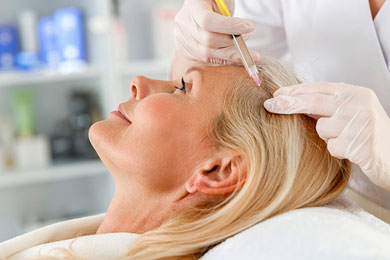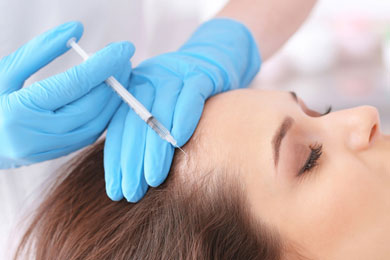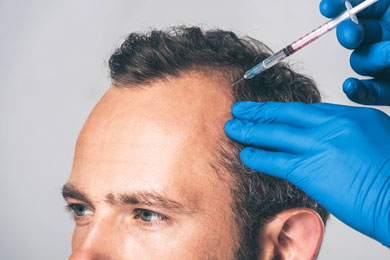
The use of adipose-derived stem cells (ADSC) therapy has gained prominence in aesthetic medicine and has a number of uses, including hair restoration, neck and décolleté treatment, and facial rejuvenation. This cutting-edge treatment improves looks and addresses a variety of cosmetic difficulties by utilizing the regenerative potential of stem cells that have been extracted from adipose tissue.
Source
Through a minimally invasive liposuction treatment, adipose tissue is often taken from the patient's buttocks, thighs, or belly.
Isolation
After being removed, the adipose tissue is digested using enzymes and then spun at high speeds to separate the stem cells from other biological elements. The pure Adipose-Derived Stem Cells (ADSCs) may be injected directly or may be grown to produce more before use.
The potential of ADSCs to differentiate into multiple cell types includes fibroblasts, which are in charge of producing collagen, a substance necessary for the suppleness and firmness of the skin.
In order to promote cell proliferation, angiogenesis, and reduce inflammation—all of which are essential for skin renewal and hair growth—ADSCs release growth factors and cytokines.
Inflammation can be decreased and the body's natural healing processes can be accelerated by the immunomodulatory abilities of ADSCs.
In order to combat aging symptoms including wrinkles, fine lines, and volume loss, Adipose-Derived Stem Cells (ADSCs) therapy boosts collagen formation while also improving skin suppleness and moisture.
Additionally, the procedure can enhance the overall color, tone, and texture of the skin, giving the patient a more youthful appearance.
In order to reduce wrinkles, sagging, and sun damage, ADSCs can renew the delicate skin of the neck and décolleté.
In certain regions, the therapy aids in skin quality improvement and firmness restoration.
ADSCs have the ability to activate hair follicles, stimulating hair growth and thickening hair. The therapy has the potential to treat disorders including alopecia areata and androgenetic alopecia (pattern baldness).
The likelihood of allergic responses, rejection, and problems related to artificial fillers and implants are decreased when the patient's own stem cells are used.
Compared to surgical alternatives, the treatment is generally less intrusive and requires less time for recuperation.
As Adipose-Derived Stem Cells (ADSCs) therapy tackles underlying causes of aging including collagen depletion, the effects can be long-lasting.
Adipose-Derived Stem Cells (ADSCs) therapy is a flexible choice because it can handle a range of aesthetic issues.
Candidates for this procedure include people who want to address aging symptoms, hair loss, or poor skin quality without undergoing invasive surgery. To ascertain eligibility, a full consultation with an experienced specialist is necessary.
Candidates could not be acceptable if they have unreal expectations, certain medical issues, or active infections.
Safety and Regulatory Considerations
Infection, edema, and bruising at the site of the harvest or injection should be discussed with the provider even though ADSC therapy is generally regarded as safe.
ADSC therapy used for cosmetic objectives must adhere to legal requirements. For the procedure, picking a reputable, licensed center is crucial.
A revolutionary method in aesthetic medicine, adipose-derived stem cell therapy provides a variety of rejuvenation and restorative applications. While promising, it is crucial for people to do extensive research, have reasonable expectations, and speak with knowledgeable experts to make sure the treatment is safe and effective. The potential of Adipose-Derived Stem Cells (ADSCs) is still being explored by the developing field of regenerative aesthetics, opening the door to more sophisticated and individualized solutions.
By utilizing stem cells' capacity for regeneration, stem cell therapy can improve the texture, tone, and general look of the skin, hair, and nails.
Stem cells are administered topically or intravenously to specific locations to encourage cell renewal, collagen formation, and tissue repair. This improves skin suppleness and delays the onset of aging symptoms.
Although some encouraging outcomes have been reported, more thorough research and clinical studies are required to conclusively prove stem cell therapy's effectiveness and safety in aesthetics.
For hair regeneration, popular locations include the scalp, neck, décolleté, and face.
In order to improve skin texture and tone, stem cell therapy boosts the production of collagen and encourages cell renewal.
Although some studies raise the possibility of advantages, more thorough investigation is needed to confirm stem cell therapy's effectiveness in treating hair loss.
The safety profile varies on a number of variables, including the type of treatment and stem cell source. A skilled professional must be consulted in order to evaluate specific hazards.
The number of sessions varies depending on the patient's objectives, the treatment location, and the particular stem cell therapy being used.
What is the recovery time for stem cell aesthetic treatments?
Recovery times vary, but many treatments require little downtime, enabling patients to quickly return to their regular activities.
Can stem cell therapy be combined with other aesthetic treatments?
Yes, it is frequently combined with other procedures like PRP, laser therapy, and fillers, but professional advice is necessary.
Are results from stem cell therapy for aesthetics permanent?
Long-lasting results are possible, but as we age, maintenance treatments may become necessary.
Is stem cell therapy for aesthetics painful?
In order to improve comfort, topical anesthetics or other pain management techniques might be utilized. Pain levels vary depending on the treatment.
Who is a suitable candidate for stem cell aesthetic therapy?
Candidates may include people looking to treat hair loss, improve skin tone, texture, and appearance, but a comprehensive evaluation is required.
Are there any side effects to stem cell therapy for aesthetics?
Redness, swelling, and inflammation are possible side effects, but when treatment is given properly, significant consequences are uncommon.
How long does it take to see results from stem cell therapy?
Results may begin to show within a few weeks, but the best effects usually take many months to become apparent.
How is stem cell therapy for aesthetics administered?
Stem cells can be administered topically, intravenously, or by microneedling, depending on the treatment.
Is stem cell therapy FDA approved for aesthetic use?
Some stem cell therapies have received FDA approval, but many applications in the field of aesthetics are still being researched and evaluated.
How do practitioners extract stem cells for aesthetic therapy?
Depending on the prescribed course of treatment, stem cells may be extracted from adipose tissue, bone marrow, or other sources.
Can stem cell therapy address wrinkles and fine lines?
Through the stimulation of collagen synthesis and skin renewal, stem cell therapy seeks to minimize the appearance of wrinkles and fine lines.
Is stem cell therapy for aesthetics expensive?
Costs vary depending on the treatment plan, the doctor, and the patient's location, but stem cell therapy is typically regarded as a high-end service.
What is the difference between stem cell therapy and PRP?
While PRP and stem cell therapy both aim to promote regeneration, PRP uses platelet-rich plasma to speed up healing while stem cell therapy uses stem cells to mend damaged tissue.
Can stem cell therapy treat sun damage?
By promoting cell regeneration and collagen formation, stem cell therapy may help sun-damaged skin look better.
Is stem cell therapy suitable for all skin types?
Determine suitability based on unique skin types and issues with a full consultation.
What are the sources of stem cells used in aesthetic treatments?
Common sources include adipose tissue and bone marrow, but different treatments may be used.
Can stem cell therapy improve skin elasticity?
Stem cell therapy seeks to improve skin suppleness by encouraging collagen formation and tissue regeneration.
Does insurance cover stem cell therapy for aesthetic purposes?
Insurance normally does not pay stem cell therapy for aesthetic purposes since aesthetic therapies are considered elective.
Can stem cell therapy help with acne scars?
Through the stimulation of skin regeneration and repair, stem cell therapy holds promise for reducing the appearance of acne scars.
What should I expect during a stem cell therapy session?
After a comprehensive consultation, the treatment region will be prepared, stem cells will be applied or injected, and after that, aftercare instructions will be given.
How do I choose a qualified practitioner for stem cell aesthetic therapy?
Examine credentials, experience, and client testimonials before scheduling a session to go over your objectives and worries.
Can stem cell therapy be used for neck rejuvenation?
Yes, neck-specific stem cell therapy can address aging symptoms and enhance the texture and look of the skin.
How long do the effects of stem cell therapy last?
Results can last a while, but maintenance treatments can help keep the effects going.
Can stem cell therapy enhance décolleté appearance?
Skin laxity, texture, and tone are all issues that stem cell therapy tries to address in order to enhance the décolleté's appearance.
Is there a risk of rejection with stem cell therapy?
Rejection risk is reduced with autologous stem cell therapy because it uses the patient's own cells.
Are there ethical concerns with stem cell therapy for aesthetics?
Embryonic stem cells are the main source of ethical issues. However, the majority of cosmetic procedures involve patient-derived adult stem cells.
Can I return to work after receiving stem cell therapy?
Many patients can return to their regular activities soon after therapy, however every patient's recovery will be different.
How does stem cell therapy contribute to facial rejuvenation?
By raising skin volume, boosting collagen production, and enhancing texture and tone, stem cell therapy aids in facial rejuvenation.
Is a consultation required before undergoing stem cell therapy?
Yes, a consultation is necessary to determine your appropriateness, talk about your expectations, and create a unique treatment plan.
Are results from stem cell therapy for aesthetics natural-looking?
By encouraging the body's natural healing processes, stem cell treatment strives to produce outcomes that look natural.
Can stem cell therapy help with under-eye circles?
Although intriguing, more studies are required to evaluate whether stem cell therapy for under-eye circles actually works.
What post-treatment care is required after stem cell therapy?
Although post-treatment care varies, it typically entails avoiding the sun, wearing sunscreen, and according to any special recommendations that your practitioner may have given you.
To sum up, stem cell therapy for aesthetic reasons is a developing discipline that has the potential to revive and renew the appearance of the skin and hair. Prospective patients must look for certified professionals and engage in in-depth discussions to determine suitability and go over expectations.
 Advances in Stem Cell-Based Therapy for Hair Loss
Advances in Stem Cell-Based Therapy for Hair LossHair loss is a common problem that affects millions of people worldwide. While there are various treatments available for hair loss, such as medication, hair transplant surgery, and topical treatments, they Read More...
 How Much Do Adipose Derived Stem Cells Cost?
How Much Do Adipose Derived Stem Cells Cost?According to a report by the International Society of Hair Restoration Surgery, the cost of stem cell therapy for hair loss can range from $3,000 to $10,000 per session, with multiple sessions required for o Read More...
 Does Stem Cell Therapy Work on Hair Loss?
Does Stem Cell Therapy Work on Hair Loss?Loss of hair is a widespread problem that affects millions of individuals globally. There are numerous therapies available for hair loss, but not all of them may be beneficial for every individual. Read More...